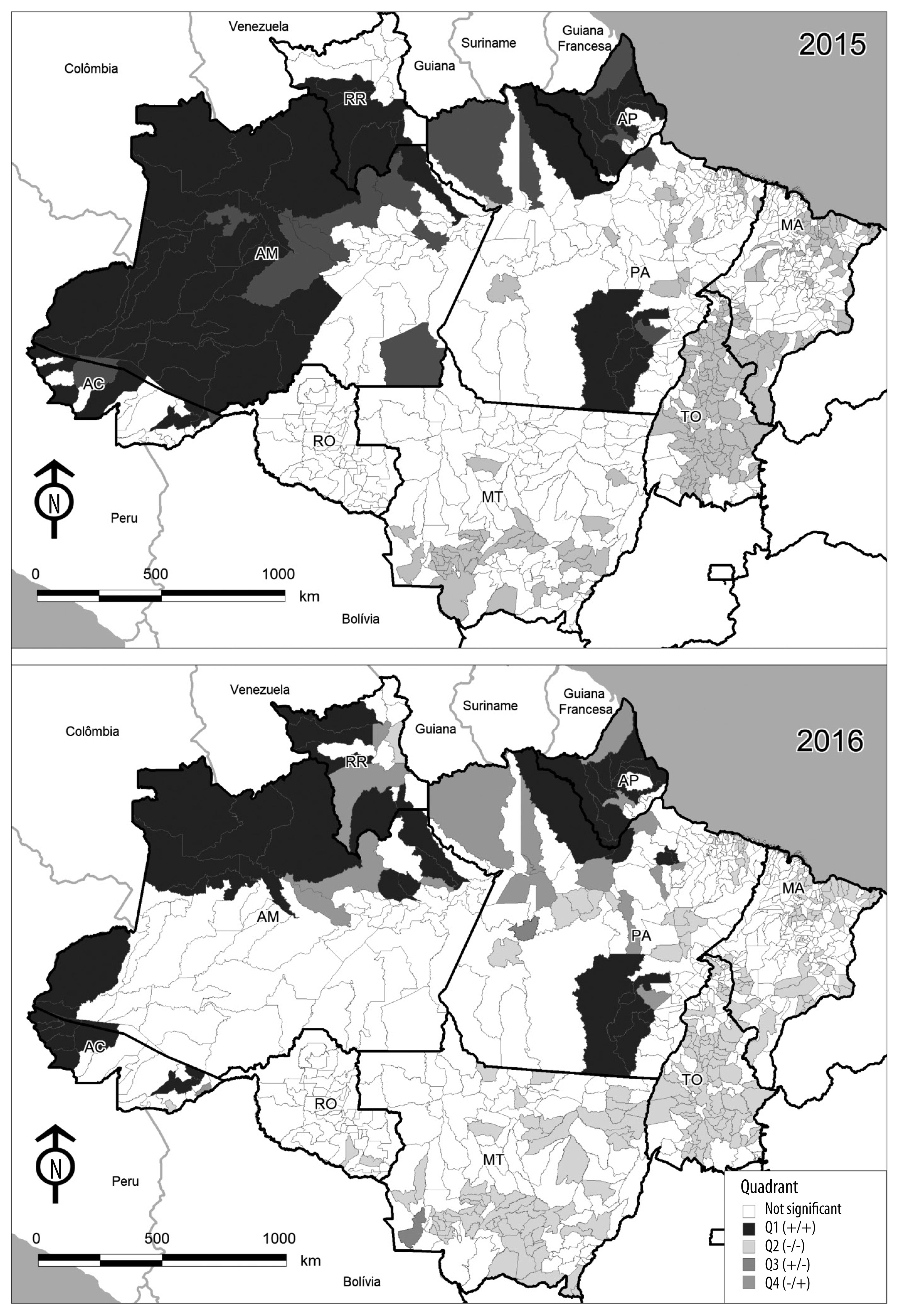Abstract
Objective:
to identify areas where malaria transmission has been eliminated and levels of malaria incidence variation in the Brazilian Amazon in 2016, and to present an indicator of priorities for control actions.
Methods:
an ecological study was conducted with data from the Malaria Epidemiological Surveillance Information System (Sivep-Malaria); municipalities were classified into three groups - elimination achieved, in the process of elimination and in search of reduction -; a composite indicator was created to stratify municipalities prioritized for control actions.
Results:
a total of 337 (41.7%) municipalities were found to have achieved elimination, 398 (49.3%) were in the process of elimination and 73 (9.0%) were in search of reduction; the priority indicator created identified 71 municipalities that accounted for 95% of cases.
Conclusion:
the vast majority of municipalities have already achieved elimination of malaria transmission or are in the process of eliminating transmission; the priority indicator may contribute to targeting malaria control actions.
Keywords:
Malaria; Monitoring; Spatial Analysis; Ecological Studies

 Thumbnail
Thumbnail
 Thumbnail
Thumbnail
 Thumbnail
Thumbnail
 Thumbnail
Thumbnail
 Legend:G1A = elimination achieved.G2A = in the process of elimination with no transmission for three years.G2B = in the process of elimination with no transmission for two years.G2C = in the process of elimination with IPA≤1 case/1,000 inhabitants.G3A = in search of reduction, with reduction.G3C = in search of reduction, with epidemic.Note: no municipality was classified in group G3B - in search of the reduction; stable incidence.
Legend:G1A = elimination achieved.G2A = in the process of elimination with no transmission for three years.G2B = in the process of elimination with no transmission for two years.G2C = in the process of elimination with IPA≤1 case/1,000 inhabitants.G3A = in search of reduction, with reduction.G3C = in search of reduction, with epidemic.Note: no municipality was classified in group G3B - in search of the reduction; stable incidence.
 Legend:Q1 (+/+) = direct positive autocorrelation.Q2 (-/-) = inverse positive autocorrelation.Q3 (+/-) = negative autocorrelation.Q4 (-/+) = negative autocorrelation.
Legend:Q1 (+/+) = direct positive autocorrelation.Q2 (-/-) = inverse positive autocorrelation.Q3 (+/-) = negative autocorrelation.Q4 (-/+) = negative autocorrelation.
 Legend:A-1 = Cluster 1.A-2 = Cluster 2.A-3 = Cluster 3.A-4 = Cluster 4.
Legend:A-1 = Cluster 1.A-2 = Cluster 2.A-3 = Cluster 3.A-4 = Cluster 4.
 Legend:Stratum 2 = municipalities with more than 332 cases per year and population ≥100,000 inhabitants.Stratum 3 = municipalities with more than 332 cases per year and P. falciparum ≥ 10%.Stratum 4 = municipalities with more than 332 cases per year, and with the quadrant Moran Map = 1.Stratum 5 = municipalities with more than 332 cases per year and population ≥100,000 inhabitants.Stratum 6 = other municipalities with more than 332 cases per year.Others = municipalities with less than 332 cases per year.
Legend:Stratum 2 = municipalities with more than 332 cases per year and population ≥100,000 inhabitants.Stratum 3 = municipalities with more than 332 cases per year and P. falciparum ≥ 10%.Stratum 4 = municipalities with more than 332 cases per year, and with the quadrant Moran Map = 1.Stratum 5 = municipalities with more than 332 cases per year and population ≥100,000 inhabitants.Stratum 6 = other municipalities with more than 332 cases per year.Others = municipalities with less than 332 cases per year.